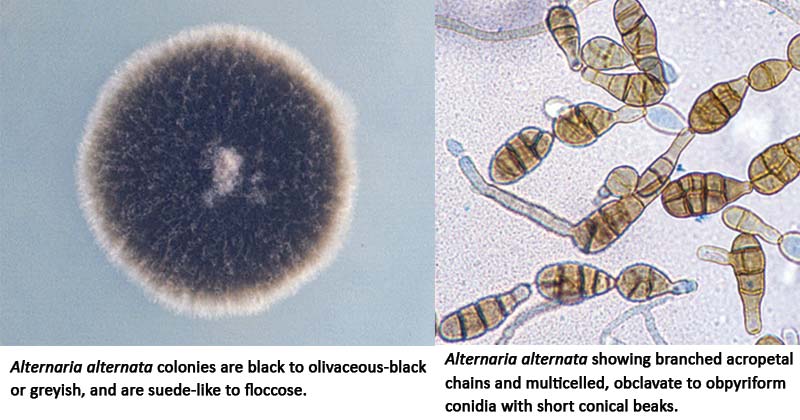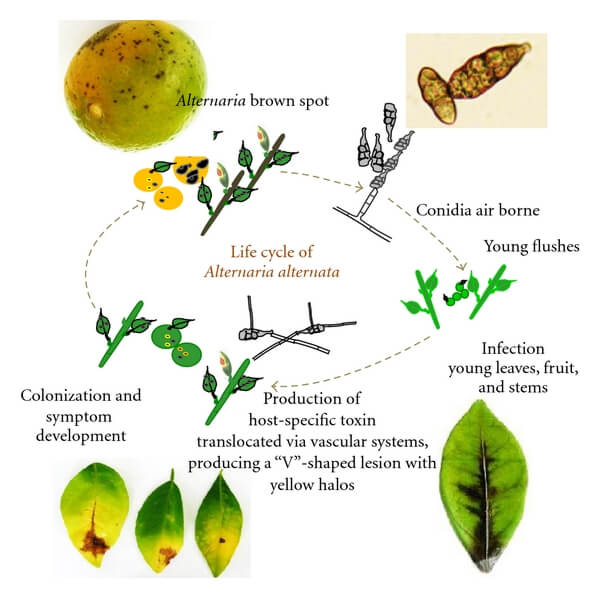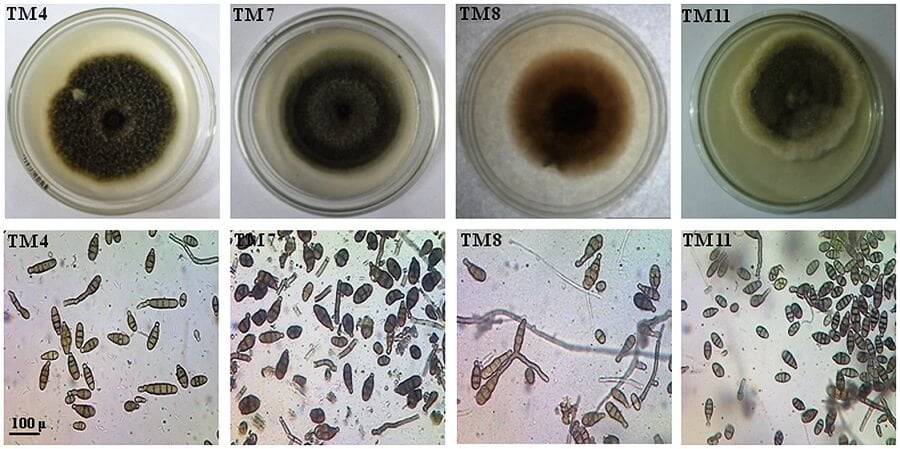Interesting Science Videos
Alternaria spp
Alternaria spp are a group of Ascomycete fungi that are known for their saprophytic nature in decomposing soil and plants. They are ubiquitous, found in soil, air, and plants. They have a clinical impact as well as, it is a plant pathogen.
There are over 299 species of Alternaria spp with the most commonly known species including:
- A. alternariae
- A. botrytis
- A. leptinellae
- A. oudemansii
- A. scirpinfestans
Some species are endophytic, living on plant parts such as seeds and fruits and can cause plant and fruit damage such as the mango rot. The clinical significance of some species in causing animal infections to include allergic (hypersensitivity) pneumonitis. Alternaria alternata is a causative agent of subcutaneous phaeohyphomycosis and mycotic keratitis. It is the most common species in this group of fungi.
Habitat of Alternaria alternata
- Alternaria species are saprophytic meaning that they thrive in decomposing materials and environments.
- They are also commonly found in organic materials and water or moisture areas.
- Some are endophytic, therefore they live in various plant parts such as seeds, and fruits.
- Alternaria alternata specifically lives in the soil as a saprophyte and decomposition organic matter.
- It is also found on plants where it caused plant diseases and can be transferred to animals through plants causing human and animal infections.
Morphological and Cultural Features of Alternaria alternata
- In culture, Alternaria alternata grows as long chains with dark brown conidiophores.
- They thrive in environments with moisture and good nutrition, producing asexual spores known as conidiospores (conidia).
- The conidia grow on the conidiophores
- The spores are large and appear dark.
- They also have short beaks and fine long septate.

Image Source: The University of Adelaide.
Life Cycle of Alternaria alternata
- Dispersion of the conidiospores is by wind or by water, landing in a suitable environment such as plant parts like leaves, fruits, or seed.
- This enables the spore to start germinating when there is enough moisture and temperatures of 31-32°C.
- They develop into long chains that start producing spores from the tips of the hyphae, which is known as a conidiophore.
- The conidiophore is pale or dark brown, appearing as a straight elongated chain or has a flexuous appearance.
- The conidiophore produces brownish conidia with short beaks.
- The conidia that develop have a smooth surface.

Figure: Life Cycle of Alternaria alternata. Image Source: Kuang-Ren Chung.
Pathogenesis of Alternaria alternata
Pathogenesis in Human Host
- Alternaria alternata has been associated with causing cutaneous and subcutaneous infections, in individuals with an immunocompromised system, therefore it causes opportunistic infections
- Cutaneous infections are localized on the skin, forming skin lesions.
- Subcutaneous infections affect the underlying layers of the skin when the fungi gain entry into the skin causing manifestations on the skin surface.
- The infections may also affect other body parts including the sinus (rhinosinusitis), the nails (onychomycosis), and the cornea of the eye causing visual impairment (oculomycosis).
- Alternaria alternata also produces mycotoxins which cause mycotoxicosis, but it is rare but not uncommon.
- Mycotoxicosis effects on humans vary from mild to chronic infections but its effect is dependent on the host immunity.
Pathogenesis in plants
In plants, Alternaria alternata causes infections such as Brown and Black spot on the leaves of plants and mycotoxicosis.
Brown and blackspot
- It affects the leaves’ plants when spores land of plant leaves and germinate on them.
- The manifestation begins on the edge of young leaves causing necrosis and chlorosis during plant development while utilizing the leaves’nutrients.
- The infection is characterized by lesions, which can also occur on the fruits of plants due to fungal growth and reproduction and fungal spread.
- On fruits such as mango, effects of mango rot are seen characterized by fungal penetration into the fruit lenticels and spread throughout the fruit.
- The infection is associated with fruit damage, darkening of the inner parts of the fruit.
Mycotoxicosis in plants
- Alternaria alternata is capable of producing secondary metabolites such as phytotoxins and mycotoxins which cause spoilage in plants.
- These elements cause toxicity that eventually causes disease.
- Infections that arise due to toxicosis include: Tomato black mold, olive black rot, citrus black/grey rot, black rot of apples and carrots
Laboratory Diagnosis of Alternaria alternata infections
Specimen: Plant Exudates, lesion biopsy, pus cells,
Cultural examination
- In Sabouraud Dextrose agar and Potato Dextrose Agar, at 28-32C, colonies grow fast producing colonies that are black-olivaceous-black/greyish and suede-like to floccose.

Image: Morphological characteristics, growth pattern, colony morphology, and microscopic examination of three potent toxic isolates of Alternaria species collected from different regions in India. All the Alternaria isolated were grown on PDA culture media and incubated at 28 °C for 12 h light/dark photoperiod. The pictures of the colonies were taken on the 6th day after the incubation of the pathogen. Image Source: Scientific Reports (Mukesh Meena et al.)
Microscopic Examination
- Using 10-20% KOH wet mount, observe for branched chains of large conidia which may appear as short branches on a long elongated conidiophore.
- The conidia are ovoid or ellipsoidal with a cylindrical beak.
- The spores are pale brown, smooth-walled
Histological Examination
- On hematoxylin-Eosin stain observe for dark-colored filamentous hyphae from tissue biopsies and pus exudates
- Fontana-Masson silver stain is used for the identification of melanin.
Treatment of Alternaria alternata infections
- Human infections caused by Alternaria alternata can be treated with Voriconazole and itraconazole.
- Amphotericin B and flucytosine are very effective in treating all infections caused by Alternaria species.
References and sources
- https://www.cabi.org/isc/datasheet/4480
- https://bsppjournals.onlinelibrary.wiley.com/doi/full/10.1046/j.1364-3703.2003.00173.x
- drfungus/knowledgebase/alternariaspp
- https://mycology.adelaide.edu.au/descriptions/hyphomycetes/alternaria/
- http://website.nbm-mnb.ca/mycologywebpages/NaturalHistoryOfFungi/Pleosporales.html
- https://www.microscopemaster.com/alternaria.html
